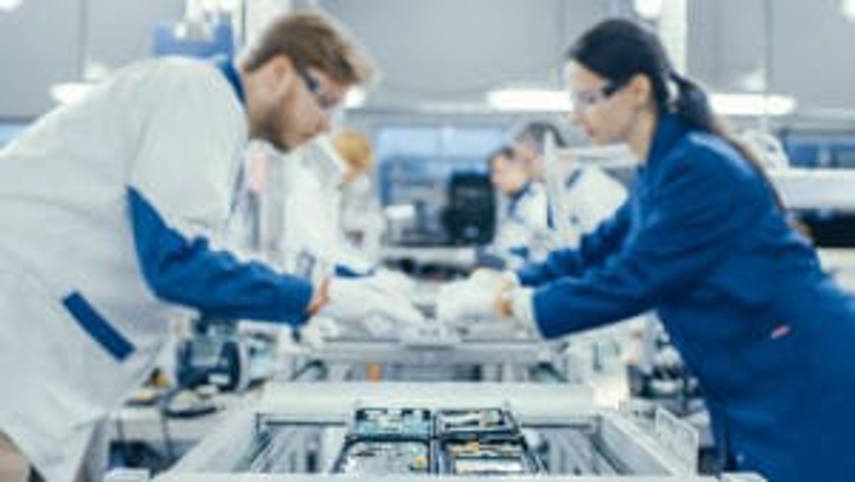
Flow production – also known as continuous production – is one of several key manufacturing processes SMEs can use. Often a highly automated process, flow production supports the manufacture of large quantities of goods.
Here we give you all you need to know about what flow manufacturing is, how it differs from batch production and one-piece flow production, and factors to consider when choosing which manufacturing method to use.
What is flow production?
Flow production is a manufacturing process that is defined by the continuous ‘flow’ of goods along an assembly line. The goods are put through different stages on the assembly line before being packaged for delivery to the end customer.
Flow production is generally a highly automated process that is suitable for manufacturing large quantities of identical, standardised products, which makes it a cost-effective way to manage a production line. This and the fact that it requires a high level of initial investment to set up means it’s generally more suited to larger manufacturers.
Alongside batch and job production, flow production is one of the three main manufacturing methods. Batch production uses machinery that is able to deliver ‘batches’ of similar products through a series of stages, such as different types of bread. Job production, by contrast, is the creation of a production from start to end, before the next product is started.
The origin of flow production is generally credited to Henry Ford, founder of the Ford Motor Company, as he created the first iterations of automobile assembly lines in the early 2oth century.
 Flow manufacturing is a common production method used to produce a large quantity of goods cost-effectively
Flow manufacturing is a common production method used to produce a large quantity of goods cost-effectively
Does flow production require a workforce?
Flow production does require a workforce, but in general the labour demands are lower than in other types of assembly lines such as those used by batch or job production.
The fact that flow production is often largely automated means it requires only minimal oversight from a labour force, although quality control checks are always needed. Businesses that use this production method can struggle to keep staff morale high, as the tasks are generally repetitive and can pay at the lower end.
Are mass production and flow production the same thing?
Mass production and flow production generally describe the same type of production method, and these terms can be used interchangeably.
The defining characteristic of mass or flow production is the large-scale production of the same or similar goods. It generally requires a high level of capital investment, but the ability to produce mass goods means it is ultimately cost-effective.
Continuous production vs flow production: are they the same?
Continuous production and flow production are generally used interchangeably to describe the same assembly line method.
However, sometimes continuous production is considered a type of flow production - specifically one involving the mixing or processing of liquids, gases, or food (e.g. peanut butter), rather than discrete products like cars.
Either way, these methods are the same in that they both require a high level of initial investment, precision in the assembly line, and a minimal labour force to manage quality control and delivery of the goods.
 Your manufacturing method will depend on the type and quantity of goods you produce, and how much product variation you need to achieve
Your manufacturing method will depend on the type and quantity of goods you produce, and how much product variation you need to achieve
What are the advantages and disadvantages of flow production?
Like any manufacturing method, flow production has many benefits - but also disadvantages. And while there are some aspects that will suit SMEs, flow production is generally better suited to large manufacturers. Here we give you an outline of the pros and cons of this production method.
The advantages of flow production
The major upside of flow production is the standardisation of the product. The machinery used in flow production is precise and requires only minimal oversight, lessening the risk for human error. A well-managed and structured assembly line will produce large quantities of the same product, at the same level of quality.
The method also minimises waste and lost labour time because it runs constantly at consistent settings. This allows the business to respond rapidly to increased customer demand at such times as the holiday season, for example.
This style of production also ensures there are economies of scale, with the large initial investment likely paid off within a short time if your business strategy is solid.
The disadvantages of flow production
The initial investment to set up flow production is likely to be significant, with the machinery required to carry out the assembly line expensive, and a high level of design work needed at the front end.
Once set up, the production method is also ‘set’ and cannot be easily changed. As such, flow production is far more suitable for businesses that have confidence the product they are creating will be in demand for a significant period of time. If business forecasts are incorrect, there is a risk of significant leftover inventory, which may be hard to offload if market demand has changed.
In many cases, these cons mean a flow production line is not appropriate for an SME.
Flow production examples: what sort of companies use flow production?
Well-known companies around the globe use flow production, such as:
- Heinz
Heinz has been using flow production to manufacture its products for years. A major American company founded in 1869, Heinz remains a significant global manufacturer of condiments and sauces.
- Coca-Cola
Coca-Cola uses flow production for its drinks production line. The Coca-Cola Company was founded in 1886, in Atlanta. Its first product was the world-famous Coca Cola drink, but it has since expanded to coffees, teas, juices, and waters – with nearly 2 billion of its drinks served every day around the world.
- Ben & Jerry’s
Ben & Jerry’s ice cream utilises flow production methods for its ice cream manufacturing. The company, founded in Vermont, offers tours of its first factory, which was built in 1985 and now manufactures around 350,000 pints of ice cream a day.
 Large companies like Coca-Cola and Heinz use flow production – but that doesn’t mean that aspects of this method can’t be used by smaller companies
Large companies like Coca-Cola and Heinz use flow production – but that doesn’t mean that aspects of this method can’t be used by smaller companies
Can SMEs use flow production?
Generally, SMEs don’t use the flow production method. SMEs by definition are smaller companies, and usually these don't yet have the need for mass production, or the capital to invest in it in the necessary equipment.
However, there are some instances where an SME might use flow production. If the business is growing at pace, for example, and has a consistent product that is expected to be in demand for several years, it may be worth considering the flow production method of manufacturing.
It’s also possible to combine and adapt your production method depending on your needs and the type of product – modern car manufacturers, for instance, use a combination of job, batch and flow production. It may be, for instance, that you produce a component or part using flow production, and the final product using batch or job production – giving you greater overall flexibility.
What’s the difference between batch production and flow production?
Batch production and flow production differ in that the former involves each ‘batch’ or group of items going through the stages and steps of production at the same time, before being completed in one lot. The machinery can then be adjusted to allow for a different style of product to be started on the assembly line.
Flow production, by contrast, is a continuous production method, with machinery specifically designed to create one product in large quantities.
Why is batch production generally better suited to SMEs than flow production?
SMEs often find batch production is more suited to their business. This may be the case for several reasons, including the ability for batch production systems to create several different types of the same product – or similar products – on the same machinery.
This method also allows for more flexibility around changes to the goods being produced – which means the ability to respond to customers’ needs.
This is often the right type of production for a baker, for example, who wants to produce different types of bread or biscuits throughout the day. It would also be suitable for a small fashion business that produces the same design in different colours and fabrics.
Batch production generally has lower initial outlay, but does require a more involved workforce to check the ‘batches’ as they go through the production line, making tweaks as required.
 Batch production is often used by SMEs since it gives the flexibility to make a variety of products in smaller quantities
Batch production is often used by SMEs since it gives the flexibility to make a variety of products in smaller quantities
What is one-piece flow manufacturing?
One-piece flow manufacturing is where one item is completed entirely at a time before the next product is started – meaning less waiting time between steps, less chance of bottlenecks in the sequence, and that the process can be driven by demand for the product. It also means that defects and errors are picked up as the process is done in steps – and changes can be made to the production line to address these.
This method is also sometimes called ‘single piece flow manufacturing’ or ‘make one, move one’, and is used by lean businesses that are aiming for a Just-in-time system.
The one-piece flow system was created by Toyota in the 1930s when it was trying to replicate a competitor’s engine and was struggling with its production line. The decision was made to inspect each piece individually before sending it further down the line.
Is one-piece flow manufacturing suited to SMEs?
One-piece flow manufacturing is often more suited to SMEs than flow or mass production. This system allows for greater variation of products, and more human intervention to check products before they are moved down the production line. It’s also more suited to smaller unit numbers, meaning it can be well suited to SMEs.
 Deciding on what method(s) to use for your business involves considerations of what space, staff and budget you have – and of course, the nature of your products and the market
Deciding on what method(s) to use for your business involves considerations of what space, staff and budget you have – and of course, the nature of your products and the market
How do SMEs choose which production method to use?
Flow, job and batch production methods can all be used by SMEs, but deciding on the most effective for you will depend on your business’s product lines and customer base.
A bakery may find batch production is best suited to its needs, while a top-end dressmaker may use job production as a method. But if you produce large numbers of identical items, flow production could be for you.
Some key factors to consider when you’re considering what type of production to use are:
- Customer base
When considering what production method might work best for your business, consider your customer base. Do your research about how their demands might evolve or change over time. Is it the mass production of small widgets that you know customers will order thousands of over the next five years? Or will you also offer customised or limited edition widgets?
- Main product line
Another major factor to consider is your central product line. The old adage ‘Stick to your knitting’ comes into play here as you consider what the main revenue driver is for your company, and what its future potential looks like. Will your bakery stick to creating full-sized loaves? Or are your customers turning to smaller baguettes as carbs fall out of fashion? Understanding your business’s profitability, as well as market trends, will be central to making a decision around manufacturing processes.
- Capital available
Beyond the customer and product being made, there will be practical decisions to be made around your finances. While you might decide mass production is the way forward, this depends on having the funds – or raising the funds – to set up this sort of system. And this isn’t just limited to the machinery required for mass production – you’ll need to consider land and warehousing requirements, as well as software and labour needs.
Under these circumstances, it’s a good idea to draw up a business plan to demonstrate how the business will grow, eventually leading to greater cashflow and profits. This way, you’ll be able to show how an up-front investment will be worth it to the bank or your investors.
- Labour force
Your available labour force may also be a constraining factor, since you’ll need certain skills for each type of production. If you are thinking of a production line that requires specific skillsets, it would be wise to explore what it will take to train your existing staff – and/or employ new staff – before moving ahead with further planning.
- Risk appetite
Finally, it will be important to assess your business’s appetite for risk. This assessment will need to encompass more than just the business’s leadership; funders and investors will also need to be on board if the vision is ambitious.
However, this is perhaps where an SME can start – with analysing its potential future trajectory, building a solid business case as to how it can maximise this potential, and finding ways to invest in its future.
- Read more about manufacturing production methods
